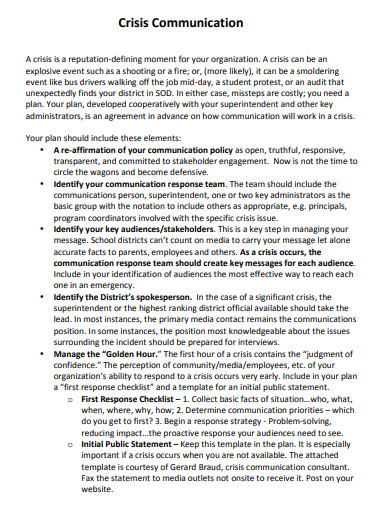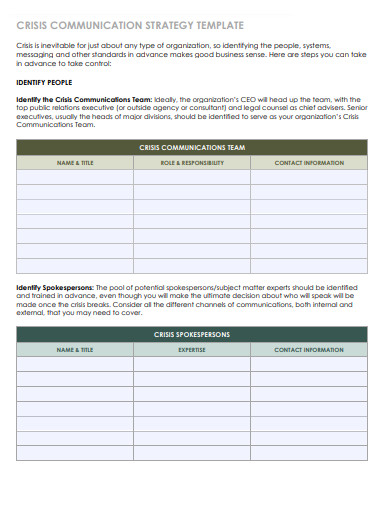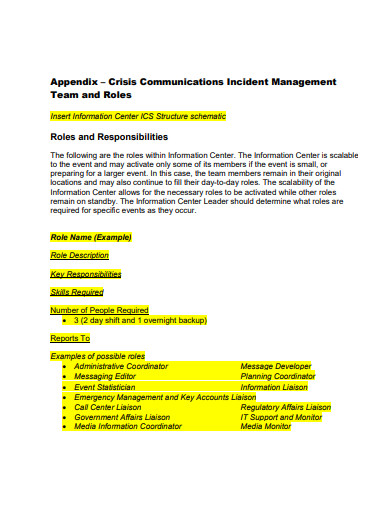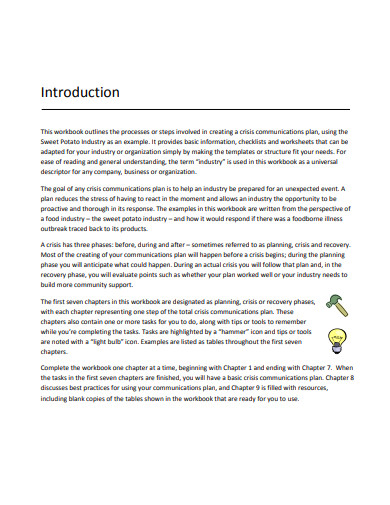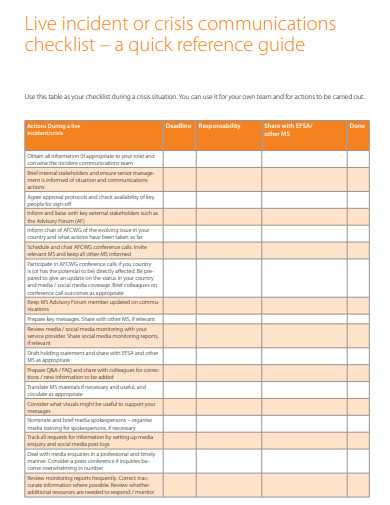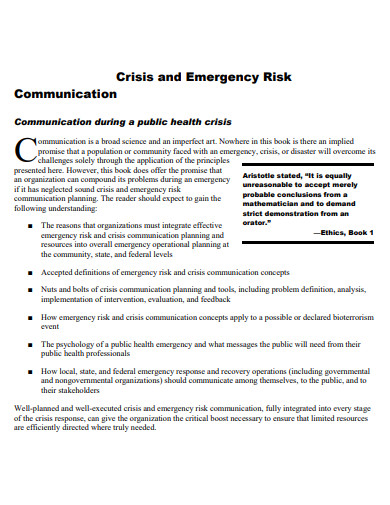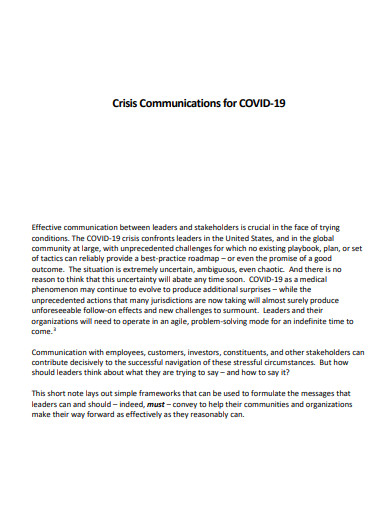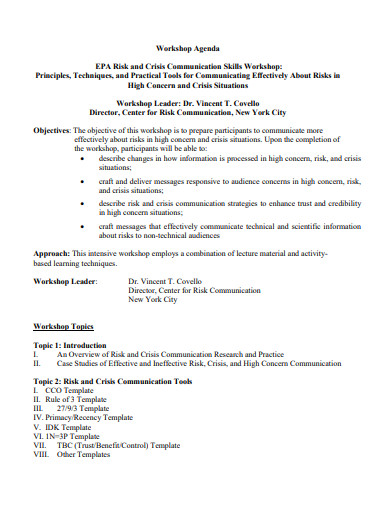10+ Crisis Communication Samples
You’ve probably heard the saying that failing to plan is intending to fail. After a crisis, threats, surprises, short reaction times, and uncertainty may influence decision-making and communication efforts. Businesses should prepare for a disaster because it helps them build a culture and a system for sending resources to the proper area as fast as possible when a crisis occurs. Crisis management planning is comparable to crisis management in terms of value. Crisis management planning, like crisis management, assists you in improving the well-being of your staff and the safety of the general public. You need to create a rigid crisis communication plan, which you could do with our help. We’ve got you covered! In this article, we provide you with free and ready-made samples of Crisis Communications in PDF and DOC format that you could use for your benefit. Keep on reading to find out more!
1. Crisis Communication
2. Crisis Communication Strategy
3. Crisis Communication Plan
4. Crisis Communication App Template
5. Crisis Communication Workbook
6. Crisis Communication Checklist
7. Crisis Communication Process Flow
8. Crisis and Emergency Risk Communication
9. Crisis Communication for COVID-19
10. Crisis Communication Skills Workshop
11. Crisis Communication Plan Example
What Is a Crisis Communication?
The collecting, processing, and transmission of information necessary to address a crisis situation can be characterized generically as crisis communication. Crisis communication is a new subject in applied communication studies that deals with mediated communications and diverse sorts of audiences during times of stress. When a crisis strikes, ethical issues are critical. The collecting and analysis of data for crisis team decision-making, as well as the design and transmission of crisis communications, are all part of crisis communication.
How to Make a Crisis Communication
Preparing ahead of time for a disaster guarantees that key individuals can communicate swiftly and efficiently during times of danger. A Crisis Communication Template can help provide you with the framework you need to ensure that you have a well-prepared and robust communication plan on hand. To do so, you can choose one of our excellent templates listed above. If you want to write it yourself, follow these steps below to guide you:
#1. Determine the plan’s aim.
Before you start, your team should figure out what the plan’s goal is. This guarantees that every part of your strategy is working toward the same goal.
#2. Determine the beneficiaries.
It’s critical to determine who the plan is intended for before you start writing. Make a list of all the people you’d want to keep updated on the situation. Personnel, consumers, and clients, associates, investors, media sources, government officials, and the general public are likely to be included on this list. In the case of a location-based crisis, this group is likely to comprise social media followers or individuals in the area. In your strategy, make sure to include all of these organisations’ contact information.
#3. Create a structure for distributing crisis information.
The individual or team who reports a problem isn’t necessarily the person or team in charge of crisis communications. As a result, a section of the strategy should be devoted to establishing a hierarchy that outlines how information should be exchanged across the organization. That way, anyone detects the issue developing will know who to contact first. The strategy should also specify what information should be given to these parties right away.
#4. Identify and evaluate hypothetical crisis scenarios.
You will most likely feel overwhelmed if a catastrophe occurs. Your thoughts will race, and you’ll feel rushed to answer phone calls, social media remarks, and media enquiries. This is why it’s a good idea to plan for typical eventualities ahead of time.
#5. Promote social media-specific guidelines.
During a crisis, proactive communication is critical. Teams should concentrate on producing press materials and distributing information about the issue to provide as much openness as possible. The more information you keep, the more others will be interested in finding out what you’re hiding. Your strategy should include portions dedicated entirely to social media crisis management.
[/ns_row]
FAQ
What are the four pillars of crisis management?
The four Ps are a mnemonic that sums up the four most important aspects of crisis management: prevention, planning, practice, and performance.
What factors influence crisis communication?
Criminal attacks, government probes, and media inquiries may all smear an organization’s reputation.
What are the steps in the crisis communication process?
The prospective crisis phase, the latent crisis phase, the acute crisis phase, and the post-crisis period are the four phases of a crisis. These classifications help us to understand how a crisis develops.
What does the crisis curve look like?
The Crisis Curve is a basic and wide paradigm for navigating transformation stages. It may be used to assist you and your team develop a common knowledge of the consequences of changes, investigate possibilities systematically, and align on bold decisions.
During a crisis, strategic communication’s main goal is to help the company stabilize and develop through instilling confidence, garnering trust, and engaging stakeholders. To help you get started, download our easily customizable and comprehensive samples of Crisis Communications today!
Related Posts
FREE 10+ School Communication Plan Samples [ Elementary ...
FREE 10+ Project Management Communication Plan Samples in ...
FREE 4+ Accounting Firm Marketing Plan Samples in PDF MS ...
FREE 3+ Cattle Ranch Business Plan Samples in PDF MS Word ...
FREE 10+ Simple Business Contingency Plan Samples in MS Word ...
FREE 4+ Marketing Management Plan Samples [ Crisis, Risk, Project ]
FREE 3+ Strategic Leadership Development Plan Samples in PDF ...
FREE 4+ Accountancy Firm Business Plan Samples in PDF MS ...
FREE 10+ Communication and Training Plan Samples in MS Word ...
FREE 9+ Communication Problem Statement Samples in PDF DOC
FREE 10+ Online Business Contingency Plan Samples in MS Word ...
FREE 5+ Charity Communication Plan Samples & Templates in MS ...
FREE 5+ Security Company Marketing Plan Samples in MS Word ...
FREE 10+ Parenting Care Plan Samples in MS Word Google Docs ...
FREE 10+ Business Emergency Contingency Plan Samples in MS ...

